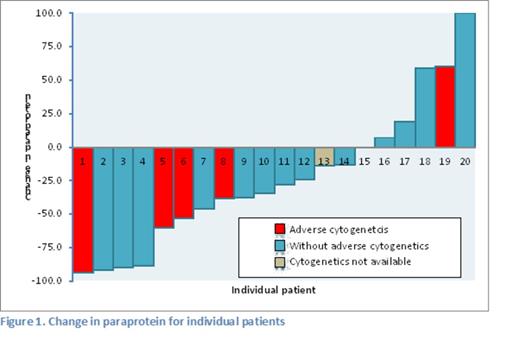Abstract
Background:
Myeloma patients receiving current first line therapies do significantly better than historically treated patients. However, patients who fail these more effective therapies are difficult to treat. A greater proportion of patients have poor tumour biology, resulting in lower response rates and shorter duration of response.
Teniposide, when studied originally in the 1980’s, achieved a response rate of 33% as a single agent in relapsed myeloma. When it was given in combination with dexamethasone and cyclophosphamide, the response rate was up to 73% in heavily pre-treated patients. It has been used in New Zealand for a number of years as second or third line therapy in myeloma, but usage was low and the drug was commercially withdrawn from availability in New Zealand in 2009. In 2012, an alternative source of teniposide was found, and use was restarted in patients who failed bortezomib and iMID (thalidomide and/or lenalidomide) therapy.
This is a retrospective analysis of a single centre experience in managing heavily pre-treated myeloma patients with teniposide based chemotherapy, given in combination with cyclophosphamide and prednisone (TCP chemotherapy).
Method:
Patients with myeloma were identified using the patient electronic database. Consecutive patients who were treated with TCP chemotherapy between 1 January 2012 and 1 July 2014 were included. Cycles were given every 3-6 weeks depending on count recovery and marrow reserve, and up to 6 cycles were given. Relevant clinical data were gathered from patients’ electronic clinical records. Data were analysed using IBM SPSS Statistics 20.
Results:
In our cohort, 23 heavily pre-treated patients received TCP chemotherapy. Baseline patient characteristics are shown in table 1. Median follow-up was 7.1 months. The median age was 62 years, and 73.9% were male. Eight patients (34.8%) had adverse cytogenetics.
The median number of prior regimens was 3 (range 1 - 7). Prior bortezomib was given in 19 (82.6%), 19 (82.6%) had received thalidomide, 12 (52.2%) had receive lenalidomide, 4 (17.4%) had previous carfilzomib, and 18 (78.3%) had prior autologous HSCT.
Twelve patients (52.2%) completed 4-6 cycles of TCP. Of the remaining 11 patients, 3 (27.3%) were still receiving active TCP chemotherapy at the time of analysis and had only completed 1 to 2 cycles, 4 (36.4%) did not respond and were switched to a different regimen, 3 (27.3%) died after the first cycle, and 1 progressed and died after the second cycle.
Treatment response, as shown in the waterfall plot (figure 1), was evaluated in 20 of the 23 patients (3 patients died prior to repeat paraprotein levels were done). The overall response rate, including minor response, was 55% (11/20) and ≥ PR was seen in 30% (3 had PR, 3 had VGPR). Three (15%) patients had progressive disease during TCP chemotherapy.
The median time to progression for the 17 patients with VGPR, PR or stable disease was 5.2 months. During the follow-up period, 12 of the 23 patients died (52.2%). Ten died due to disease progression, 1 from TCP related toxicity (infection), and 1 died from an unrelated issue. For all cause mortality, the median overall survival was 6.1 months.
Conclusion:
TCP chemotherapy was well tolerated with more than half of the patients completing 4-6 cycles, and only one died from TCP related toxicity. In our heavily pre-treated cohort, over half had their disease held at bay for the duration of the TCP treatment. This result is comparable to that published for pomalidomide and dexamethasone in a similar patient cohort. While there are a number of promising new agents being developed, older therapies, such as TCP, should not be overlooked, as it is an effective regimen even if patients have failed proteosome inhibitors and iMID therapy.
Simpson:Onyx: Honoraria, Research Funding; Celgene: Honoraria; Janssen Cilag: Honoraria.
Author notes
Asterisk with author names denotes non-ASH members.



This feature is available to Subscribers Only
Sign In or Create an Account Close Modal